Page 1 of 1
Aluminum storage container
Posted: Fri Sep 10, 2010 8:21 pm
by jakeru
Hi all - I built from customer's plans a storage container, which is thankfully now completed and delivered.
Specs:
10" diameter x 27" tall cylindrical container, with an easily removable, gasketed lid
welded handle constructed from miter-cut tubing (6061, .065" thick, 5/8" OD)
5052 aluminum main barrel (.065" thick) and end plates (.080" thick)
TIG welded with a rock-solid reliable, 3 year old Everlast Super200P and 3/64" 5356 filler rod
The completed barrel is so strong, with it laid down sideways on the floor, I could stand on the open end without it deforming at all. (The lid would still make a perfect fit afterwards.) That said, the thick, strong barrel was a *real PITA* to form into a cylinder!
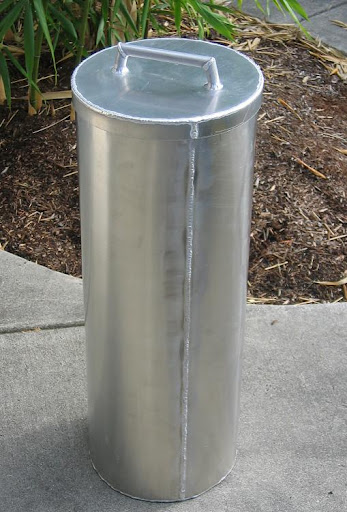

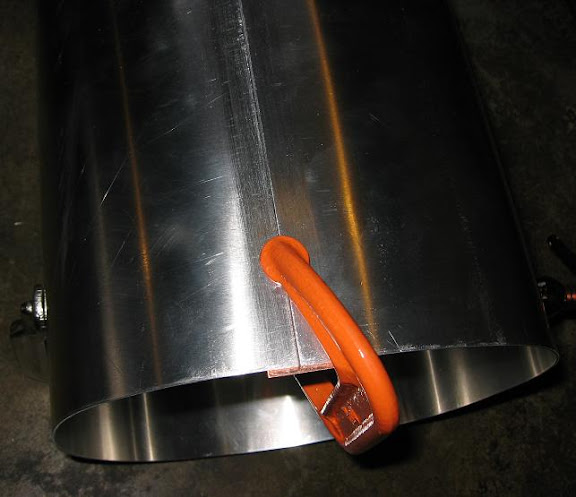

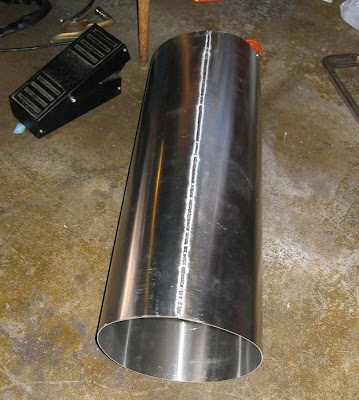
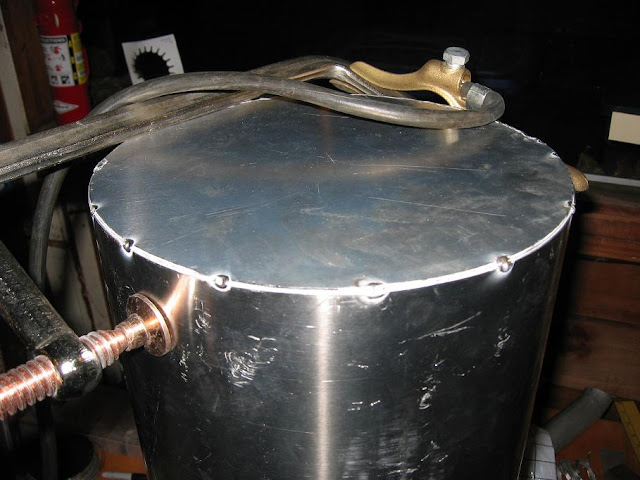
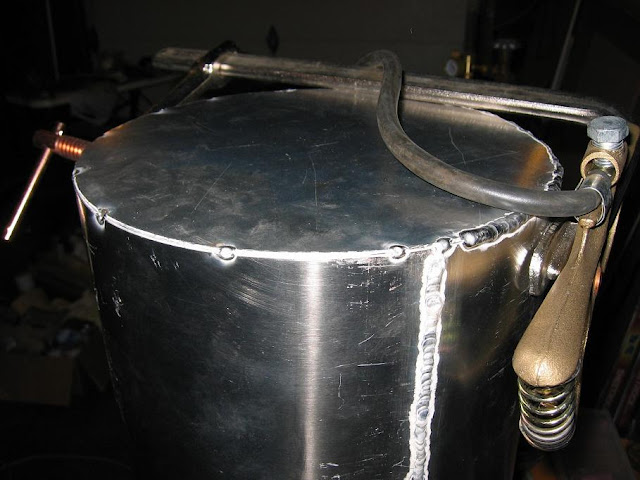
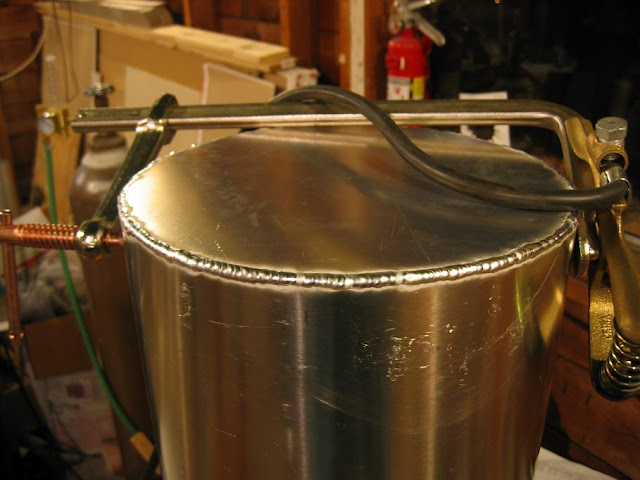
Re: Aluminum storage container
Posted: Fri Sep 10, 2010 8:28 pm
by jakeru
Re: Aluminum storage container
Posted: Fri Sep 10, 2010 8:45 pm
by jakeru
By the way, a portion of the proceeds from this job went towards buying a two-pack of Jody's Tig Fingers, which I look forward to trying out!
(...also my small way of saying "thanks" to Jody, for hosting just a great and informational forum and web site / blog.)
Re: Aluminum storage container
Posted: Fri Sep 10, 2010 11:17 pm
by billyolds
jody does have a cool site!
pretty cool container you built there. If you dont mind me asking what'd ya charge? Or better yet what went into figuring out what t charge?
Re: Aluminum storage container
Posted: Sat Sep 11, 2010 3:20 pm
by jakeru
I'd rather not directly answer the first question, but can help you with the second.
I charged in this case for actual materials cost + labor. Materials cost was easy - how much did the stuff I bought cost to complete the project? I can estimate this accurately by making a schedule of all the parts necessary to complete the project, and contacting my preferred materials supplier for a price quote. In this case, materials cost was $75, and that included the materials being delivered to me, sheared into the rectangular pieces I needed (saving a good bit of labor.)
For labor, I charge based on actual time spent, at a predetermined hourly rate. Usually a project like this is broken down into a series of tasks to be completed. Breaking it down allows easier estimating as well as tracking of time spent on each task. They add together to make an overall total. In project management methodology, the broken down list of tasks is referred to as the "work breakdown structure".
In this project's case, I went over my estimated labor on the task of bending the main barrel into a cylinder, because the material was a lot stronger and wider than I was anticipating at the beginning. I had to buy some extra, large clamps I wasn't planning to need in the beginning. This also kind of snowballed into me having to add an unanticipated task of forming the opening into a more round shape (to get the lid to fit easily on and off with one hand, without forcing it.) You can almost plan on this kind of unexpected thing to happen especially if doing something new, so be sure expectations are clear up front when it does happen, who will take the loss - the contractor (fixed price), the customer (fixed labor rate), or if it will be shared. If its you, pad on some extra in your price quote; you should be getting paid to take a risk.
Also at least on small jobs I have done, I don't bother tracking "nickel and dime" type costs - the cost of argon, tungstens, a small amount of inexpensive/common types of filler rod, general tool wear, etc. Those aren't worth tracking in small jobs, and can just be built into an hourly labor rate instead.
Oh yeah, its also a good idea to get paid for a portion up front on a bigger project; which could just be for materials. It should be enough to ensure the customer has a stake in the project and won't "walk", while not being so high that the customer would be anxious that the contractor "walks" without completing it. Its perfectly reasonable IMO, to ask for the materials cost to be prepaid. For very large, long projects, you also could ask for payments upon completion of prespecified project milestones. (You would plan this out, and get an agreement on the specifics up front, of course.)
Hope this gives you some food for thought.
Re: Aluminum storage container
Posted: Sun Sep 12, 2010 1:32 pm
by billyolds
jakeru,
Thanks for the great reply! So far in my very very short welding career i havent done anything but get paid hourly and have all my consumables and such paid for. I am trying to find side jobs like this stuff for extra money and pricing stuff is tuff as a newer welder. Appreciate the info.
-billy
Re: Aluminum storage container
Posted: Sun Sep 12, 2010 2:45 pm
by jakeru
I am experimenting with doing welding type of work on the side as well Billy. Although for me welding is not my main career path, its just a hobby.
I kind of like the smaller, "fix-it while I wait" type projects. Here is one a customer brought me - an automotive thermostat housing that needed to have a new outlet created and repositioned, to complete an engine swap. It was real dirty (oily dirt on the outside, coolant scale completely covering the inside) and he wanted me to do it as cheaply (quickly) as possible. I cut a piece of tubing I had and fit it up to the part he brought. I put a real thick weld bead on it, but some coolant scale contamination from the inside I had a hard time cleaning caused some porosity in some areas of the bead. Still, I'm confident the weld will hold water, as the bead is quite thick all the way around. It had a pretty sloppy parts fit-up (customer kept "tweaking" the angle he wanted to the tube to be at, understandably to clear everything in a tight engine bay,) it just made it take more time that one might have guessed it would.

I got a pretty irregular weld bead, but the customer said it wouldnt even be in a visible location, so didn't care if it wasn't pretty. I did inform him the weld would distort the flange, (it was actually noticeably distorted before I did any welding) and I instructed him how he could flatten it when he got home with a sanding block or a flat file. I guess I gave him what he asked for?

I could tell by his face he was a little disappointed with the porosity, (he turned out to be one of those guys that wants it all, but I don't blame him), but he was real happy in the end after I put that beaded lip on there. He said his whole engine swap project has been held up for a while on just this one part, so apparently it solved a big problem.
I think being able to provide a service like that, quickly while someone waits is pretty rewarding.

I might continue doing this kind of work on the weekends.
These types of very small projects I like to keep real simple with billing, and just ask for a fixed rate per minute, unless there is some extraordinary materials I am using or something. I prefer not being real firm on a time estimate up front, and instead invite the customer to watch me work if they like, and track the time spent on the project together. They almost always want a general idea of how long I think it will take, before starting. The piece of tubing I cut from a section I had on hand, I could have asked for a small charge for, but decided not to (it would not have been a large fee) to keep the billing simple. I have stocked up on a variety of small pieces of material, in various thicknesses and sizes, for tackling small projects like these; it has come in real handy.
Re: Aluminum storage container
Posted: Fri Sep 17, 2010 8:42 am
by ogorir
I haven't tried it yet, but jody's suggestion of cooking dirty aluminum on a gas grill for a while should help with stuff like that (haven't had to weld any super dirty aluminum since I read it).
I know for 'semi-dirty' stuff, like austin healy front and rear shrouds*, I take and light up w/ no filler and dance the torch around in say nickel sized areas along my weld area to raise the crap out of the weld, then wire brush/file, then weld as normal. at first I'd just go along the entire length of the weld, then wire brush, but I think by doing that I ended up burying some of the crap back in the weld. it piles up right at the edge of the puddle.
it doesn't make it come out completely pore-free, but it makes it easy to weld. as it's just non-structural sheetmetal (and 1100 series at that) it's structural integrity is about the least of my concerns, so long as it will take vibrational stress and not crack the pretty paint I put over it.
*the hood and trunk surrounds are removable aluminum panels. because everything else that bolts to them is steel (fenders, hood, trunk, grille) you get lots of galvanic corrosion at and near the edges.
Re: Aluminum storage container
Posted: Thu May 03, 2012 11:27 am
by bobhdus
Great work! On the topic of hourly rates though, I run a Locksmith Business and do a lot a welding on the side under that business permit. My Locksmith rate is usually $60/hr. Since most of my lock customers are the ones offering me welding work, I will just charge them the same rate. There is one business in my community that offers welding services and they charge a lot more than me. But I don't have any overhead or workers under me so I don't really need to match them. But then again, it really is not wise to be the cheapest one in town either. This Locksmith Business is all part time work. My Main job is working for a Manufacturer in the Maintenance Dept. I started this Business last December 2011 but plan on taking my Company buyout in August 2012 to take my personal Lock and weld business full time. One other thing... If you own your own business sometimes you can get a wholesale price on Materials. I get my Material (steel, Aluminum etc...) at a discount anyways because of my employee discount with my full time job, so I always mark my Material price up and profit with the difference of what the customer would have paid without a discount. At my lower hourly rate, people can afford to do the small jobs. I weld old broken cast iron lamps, I make Welded Art Sculptures, I'm building a frame for a hot rod kit car for another customer etc... Welding keeps me busier than doing the Locksmithing.







